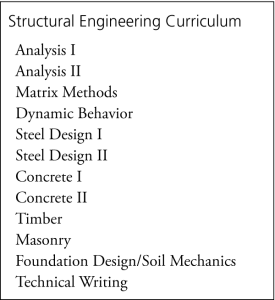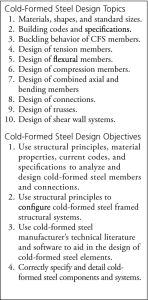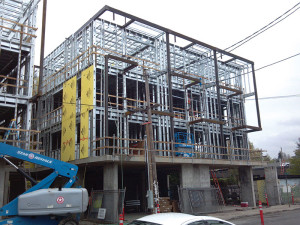Should Cold-Formed Steel Coursework be Included in the Structural Engineering Curriculum?
Unlike the United States Constitution, the National Council of Structural Engineers Associations (NCSEA) recommended structural engineering curriculum suggested by practitioners for structural engineers is a living document that engineers need to review on a regular basis. In some cases, such as in technical writing, the monitoring by our profession and academic institutions results in a modification to the program.
Academic institutions have found ways to incorporate technical writing, which is simply a title for the need for engineers to communicate in an effective way on a technical and lay person level. A short while ago, member organizations and readers of STRUCTURE were exposed to suggested modifications to the two-part Concrete Curriculum. Generally speaking, these suggestions were to make Concrete 1 the “Introduction to Reinforced Concrete”, and Concrete 2 the “Advanced Level of Reinforced Concrete”. Pre-stress and Post-tension Concrete would be a separate three-credit course that would be offered by schools as an elective. In that regard, the mission of NCSEA would be to inform practitioners of the potential change, and learn from those practitioners if a two-course concentration in reinforced concrete was more beneficial than the current curriculum, or perhaps become a geographic alternate dependent on particular practitioner needs.
The following article, authored by Brent Perkins, P.E., S.E., on behalf of the Basic Education Committee and in response to comments from industry, practitioners, and other stakeholders, is a suggested course on Cold-Formed Steel. A subsequent article currently being prepared by Professor Kevin Dong, P.E., a long-term member of the Committee, combines Timber and Masonry. Combining these two programs is a response to practitioners suggesting there is a real need on the part of young engineers to have academic exposure before joining the workforce, and a nod to academic institutions that may not have the resources to provide two (2) full three-credit courses.
In another area, Professor Judy Liu of the Committee and Professor Dong are suggesting an update to the course content for Structural Steel I and II to reflect a University perspective. Please stay tuned to STRUCTURE and other communication outlets as the Basic Education Committee of NCSEA reaches out for stakeholder and practitioner input.
Craig E. Barnes, P.E., SECB
Is it time to include cold-formed steel coursework as part of the structural engineering curriculum recommended by the National Council of Structural Engineers Associations (NCSEA)?
Since 2002, the Basic Education Committee for NCSEA has recommended a core 12-course schematic as the Structural Engineering Curriculum (Figure 1). This curriculum includes subject matter deemed necessary by the profession for all structural engineers. In the years since the implementation of this schematic, the NCSEA Basic Education Committee has received questions as to how or if cold-formed steel should be included. The current curriculum recommendations do not include cold-formed steel design. NCSEA has continually sought input concerning the curriculum since its inception. As practicing engineers and educators, do you believe cold-formed steel design coursework (Figure 2) should be part of the recommended curriculum?
Cold-formed steel framing is obviously no longer being used exclusively for exterior curtain wall framing and interior non-load bearing partition wall framing. Cold-formed framing systems are now being implemented as the primary vertical and lateral load carrying systems for complex single and multi-story cold-formed structures. How did you or your colleagues obtain a competent level of understanding for cold-formed steel design? Did you attend a technical cold-formed steel design presentation? Did you teach yourself the American Iron and Steel Institute (AISI) North American Specification for the Design of Cold-Formed Steel Structural Members? Is it appropriate for NCSEA to not include cold-formed steel design coursework recommendations regardless of the changes that have occurred in cold-formed steel construction?
It may sound as if the Basic Education Committee is strongly encouraging a response from practicing engineers and educators to support the addition of cold-formed steel design as part of the recommended curriculum. However, this is not necessarily the case; the committee recognizes that the future structural engineer’s college education path is already filled with recommended coursework that is a challenge for students to complete. How can another curriculum recommendation be added? Should some of the recommended curriculum be revised to elective courses – if so which ones? Should some of the recommended curriculum be combined or eliminated – if so which ones? Or should the recommended curriculum remain as it was originally introduced without cold-formed steel design?
The Basic Education Committee has repeatedly sought feedback concerning the recommended curriculum through forums at the NCSEA Annual Conference, articles in STRUCTURE magazine, and discussions with practitioners and educators. Now the committee needs input from a broader spectrum of professionals to move forward and make a formal recommendation. Tell us what you think. Should the curriculum remain unchanged or be modified to include cold-formed steel design?
Provide feedback to the Basic Education Committee by contacting Brent Perkins, NCSEA Basic Education Committee Chair, at bperkins@dwase.com.▪




